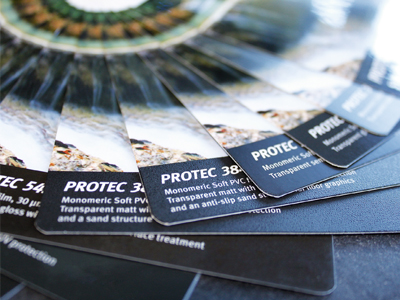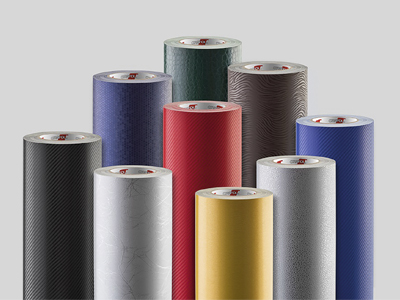Fan fun – examples of the Mactac PermaFun range available from Amari
Digital Supplies
Whether it’s for protection or for visual enhancement, there are still plenty of reasons to laminate wide-format output. Michael Walker reports
Output from wide-format printers finds its way into a variety of situations where it has to face tougher environmental conditions than most print and is expected to last much longer, resisting rain, sun, air pollutants, temperature extremes, scuffing or even pedestrian or wheeled traffic.
The solution, long before digital print became popular, was lamination. And it still is, according to Chris Green, head of channel, visual communications at Antalis, who says, ‘We know that the market will ultimately reduce, but it’s misguided to say that we don’t need lamination any more, as inks typically only last up to around two years without protection.’ Various grades of protective laminates can extend that to three, five or even ten years, which might be required in signage installations, for example.
Kellie-Anne Moore, sales and marketing manager at Soyang UK, which handles the German Intercoat and Portuguese Decal ranges of laminate products, also suggests that the ink manufacturers’ claims ‘do tend to get across, but in my view, anything external should be laminated to protect against UV and pollution’.

Swatch available from Soyang UK shows the variety of intercoat laminates
Tim Stockley, director at Colourbyte, which sells the TuffGuard range, also points out the difference in laminate adhesive types: ‘Solvent acrylic adhesive is better than water-based for outdoor use; it’s more effective against water ingress.’
Hot or cold?
There’s also the distinction between cold lamination films, like the Avery Dennison range, which are applied just using pressure, and hot encapsulation types, sold by Papergraphics amongst others, that require heat to melt and activate the adhesive component. While Mr Green opines that most lamination films “do like some heat”, Mr Stockley points out that the hot melt encapsulation products generally require treating both sides of the substrate or else it can curl, which is potentially wasteful unless the product is something like a menu or table mat that really needs protecting on both sides.
Then there are specialist applications, such as anti-graffiti, dry-wipe and anti-microbial laminates, used variously in public spaces, schools and hospitals. Anti-graffiti types do their best to resist marking, though their benefit is as much about cleaning off the ink or paint afterwards as it is resisting it in the first place. ‘Polyester repels pens and spray paints, though not 100%, but solvents can’t bite into polyester. It’s better than vinyl, which pulls in the solvents so they can’t be removed,’ says Mr Stockley.
There are also variants designed for floor graphics use, where pedestrian grip is as important – if not more so – than durability. Ms Moore comments that ‘A lot of manufacturers are trying to build non-laminated products for flooring, but we still sell kit systems of a printable film and a thick top-coat anti-slip 200-micron laminate; we don’t think the durability works.’
Mr Stockley agrees, even though he does sell a non-laminated direct-to-floor product: ‘There’s nothing better than a physical barrier between your foot and the ink,’ he says.
Eye-catching
As well as the protective role, lamination can play an aesthetic one, whether it’s effectively invisible, as in the case of matte films that diffuse directional lights to reduce reflection and glare in exhibition and display applications, or to catch the eye via “linen”, “peach skin” and “carbon fibre” textured or mottled finishes, and even films that have glitter embedded to attract attention and complement the print underneath. Mr Stockley reports having experimented with leather and stone-textured laminates but not found great commercial success with them.
There’s another practical consideration: ‘Lamination makes installation easier because material such as self-adhesive vinyls become stiffer,’ comments Mr Green, though he’s also firmly of the view that the lamination process itself requires specific skills that aren’t always present since wide-format production stopped being the sole preserve of dedicated signmakers. He says that Antalis runs a “digital academy” at its Leicester headquarters where courses in these kind of skills are offered.
Vehicle wraps require lamination as a matter of course, with an over-laminate protecting the printed layer. Flexibility is of course a key requirement here, in order to get the complete laminate to conform around the various curves and hollows. Vehicle wrap materials are therefore sold in matched pairs. While there’s nothing to stop users mixing and matching the components, Mr Green suggests that there is peace of mind in buying the matched materials, as the polymers in them will move at the same rate and that there are potential warranty issues with using untested combinations.

Coats of many colours – some of the Orafol range from Antalis
Antalis offers the Drytac, Coala (its own-brand) and Orafol ranges of laminate materials which Mr Green points out are all manufactured to UK or European standards and while this might make them more expensive compared to Far Eastern alternatives that have become available in the last few years, warns that the extra cost is “nothing, compared to de-lamination,” citing horror stories of lamination failures at multiple sites.
While lamination technology dates back to photo lab days, developments in digital print have spurred changes to the product types that are now available. Mr Green explains that while the over-laminate film types mostly haven’t changed, the adhesive properties have. ‘Seen under the microscope, UV print has peaks and troughs and you need a heavy [adhesive] coating weight to stick well to that.’
Sustainability concerns are creeping up the customer agenda, and laminate manufacturers have responded by introducing PVC-free variants but the onus is very much on the user to strip the material in order to present it for recycling. Ms Moore also reports that in trials, installers struggled with non-PVC products and found that some took two to three times as long to fit.
‘PVC has a bad reputation but the nasties have been taken out of the plasticisers; it’s maybe more environmentally-friendly than polyester or polypropylene which are more oil-based,’ she says.
Michelle Gains, internal sales manager at Amari Digital Supplies, which sells 3M, Mactac and the A-laminate own-brand range products, has the opposite view: ‘PVC-free is easier to handle; it can obtain more heat in vehicle graphics. It’s almost impossible to burn – it’s OK to 170 degrees C – so better for a more inexperienced fitter.’
UV and Latex printing might have reduced the need for mounting lamination in some direct-to-substrate print but the protective and visual enhancement applications aren’t going away. The choice has never been wider.
Read the full August issue of Digital Printer magazine here. Subscribe to the magazine for free – register your details here.





